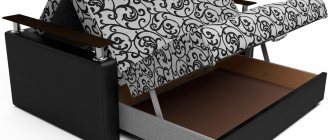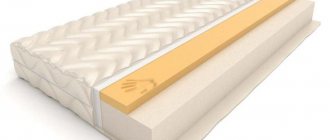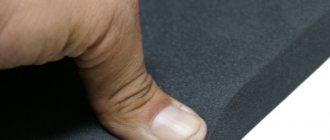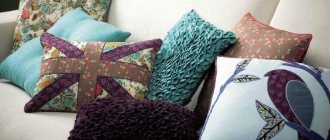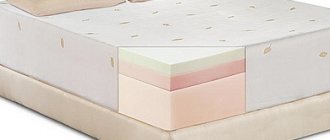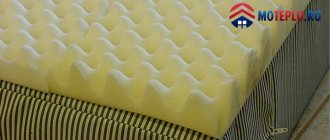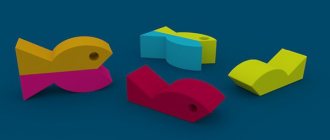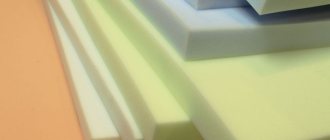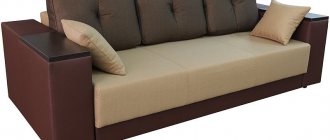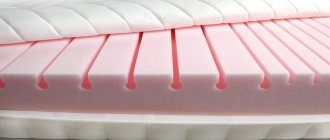New leather soft sofa for a beautiful living room
Many, having completed renovations in their apartment, purchase new upholstered furniture, if funds, of course, allow. But the choice must be right. In addition to the durability, cozy appearance, and transformation mechanism, you should pay attention to the filling and ask the seller what the “filling” of the sofa is. How comfortable you will be depends on this. Nowadays there are a lot of fillers, you need to have an idea about some of them, their quality, quality factor, how long furniture with such a filler can last.
Types of fillers for upholstered furniture
Furniture manufacturers often use polyurethane foam (PUF) as filling. Lots of box spring sofas. Buyers are sometimes confused as to which is better, a spring or polyurethane foam, and cannot make a choice.
Blue orthopedic sofa with spring block in section
Sectional view of a sofa with polyurethane foam with a list of materials and components
First of all, about the terms.
What is now fashionable to call foam used to have another common name - foam rubber. However, at all times, the name of the material itself will be relevant and unchanged - polyurethane foam (a foamed form of polyurethane - an elastic rubber-like plastic).
Polyurethane is the undisputed hit of our century, which, due to its properties (stability, hypoallergenicity, chemical inertness, elasticity), is used in the vast majority of branches of human activity from the automotive industry to implantology.
Alternative names for polyurethane foam only confuse the consumer - polyurethane foam, latex foam, viscolatex, artificial latex, etc.
Advantages and disadvantages
Elastic polyurethane foam is used in the furniture and automotive industries
Polyurethane foam has pros and cons. Let's look at the positive properties.
- The main quality is that dust does not accumulate in it, it is completely hypoallergenic. This ability is important for those who are prone to allergies.
- During production, it is treated with an antibacterial and antifungal agent, so it does not cause harm to health.
- Can last a long time and is wear-resistant.
- Has good breathability.
- Thanks to its elasticity, it instantly restores its original shape.
Imprint of hand shape after pressing on viscoelastic polyurethane foam
There are also negative properties
- Often you come across poor quality polyurethane foam - it will quickly lose its original shape, and the furniture will quickly sag.
- The material does not tolerate direct sunlight and begins to deform. During production, upholstery made of light-protecting materials is used.
- Polyurethane foam is a flammable substance and releases toxic substances when burned.
- For many, the high density of PU foam may seem hard.
- Excessive softness of the material can cause back problems, and in children - curvature of the spine, so it is better for them to sleep on a hard surface.
Can you list all the names of polyurethane foam so that I can no longer be deceived?
Certainly! Get it!
- Foam rubber
- Foam
- PPU
- Latex foam
- Foam
- Highly elastic foam
- Vegetable foam
- Foamed corn oil
- Artificial latex
- Waterlatex
- Tiger touch
- Wisco shawm
- Sloth
- Memory
- Memorylatex
- Smart foam
Want to understand foams better? Please!
There are few main technical properties of the foam - only 3 pieces. This:
- Foam grade (ST, EL, HR, HS, LR, HL) - characterizes the formulation and elasticity properties of the foam;
- Foam density - the amount of material per cubic meter, kg/m3 (kilogram in 1 cubic meter), is responsible for the reliability and price of the material.
- Foam hardness index - measured by pressure per m2 in kPa at 40% compression.
However, the line of polyurethane foams is very diverse; in the world you can find more than 50 different combinations of brand/density/hardness of foam - and each option is unique and has different properties from the others.
Exclusive offers on selected models
As mentioned earlier, the ST brand of foam rubber is considered to be the “gold standard” in the production of any upholstered furniture. However, there are also denser, more advanced polyurethane foam materials, which almost no one uses in their production today. The manufacturer Barski offers a choice of either standard high-quality models made of durable foam rubber, or improved options of ideal quality:
- HS – blue-colored high-strength foam rubber. For example, it is used to tighten Soft chairs in the so-called “working zones” - on the central part of the seat, back, where friction and pressure are most intense. It is interesting that such polyurethane foam does not shrink even when pulled onto the headrest frame, but remains just as soft and dense;
- EL 32 40 – increased strength polyurethane foam, which also helps to increase service life and is used in the production of the Chief series of chairs.
It is noteworthy that HS grade polyurethane foam is used in automotive production and has proven itself to be the most wear-resistant soft filler.
Many of the buyers, when choosing a comfortable chair for themselves, prefer to sit on it, try it out, as they say, during work, and this is correct. But we should also not forget that in many ways, the shelf life of such a product is a combination of several factors, the quality of foam rubber among which is also the most important. Trusting a trusted Ukrainian manufacturer means not only guaranteeing comfort at work and at home, but also ensuring trouble-free use of furniture for 5-10 years.
I want to understand better about brands! Can you help?
No problem!
- ST is a standard brand of polyurethane foam, the original classic, the foam that started it all. Neither hard nor soft, fluffy foam with excellent recoverability at good densities;
- EL - a reinforced grade of polyurethane foam, was invented much later, but today has taken a dominant position in many market niches, thanks to its increased rigidity;
- HL - extremely hard foam, used in conditions of increased loads and for maximum durability;
- HS is an ultra-soft foam used in low densities in headrests and armrests of furniture. In tall ones it turns into waterlatex - into jelly superelastic foam;
- HR is a highly elastic, rubber, latex-like brand. Extremely popular in mattresses for its springy elasticity.
- VE (LR) is a viscoelastic brand, memory, which is called by many names, including “smart foam that remembers you personally.”
The best springless natural fillers
Any filler that is used in the production of upholstered furniture or mattresses has its own properties.
- Natural latex. It is made from the sap of the rubber tree using individual technology. It is foamed, resulting in the formation of cells, so it “breathes”. Excellent heat and moisture conductivity, solid material, very high quality. Shelf life is approximately 10 years. Instantly returns to its original shape after heavy loads. There is only one drawback - the very high price.
Latex mattress - high quality, comfortable and safe
- Horsehair. Excellent filler. The horse's mane is treated with latex. This is done to ensure that the material is elastic and long-lasting, moisture-resistant, and breathable. High quality filler, but expensive. Not suitable for people prone to allergies.
Horsehair for the production of upholstered furniture and mattresses
- Coconut coir. Fibers are produced from the coconut intercarp; just like horsehair, they are treated with latex to make them elastic and strong. In addition, they also have antibacterial properties, are hypoallergenic, environmentally friendly, do not rot, and are breathable. Furniture with such filling is perfect even for small children.
Coconut filling for children's mattress
- Sea grass. The most environmentally friendly filler. During manufacturing, the raw material is combined with jute. The furniture has sufficient rigidity, which is beneficial for the back and maintaining the health of the spine. In addition, this filler strengthens the immune system and normalizes sleep, as it contains iodine and various minerals.
Useful and healing filler for upholstered furniture - sea grass
- Bamboo fiber. Produced from young bamboo shoots. The material is able to absorb water vapor, allow air to pass through, and has anti-allergic and antibacterial properties. It is not subject to rotting and does not deform for a long time.
Bamboo fiber is ideal for mattress covers, blankets and pillows
- Camel's wool. Excellent breathable material, can absorb static electricity. Not suitable for people prone to allergies.
Camel wool is an excellent warm filling material for blankets, pillows, blankets, mattress covers and winter mattress options.
- Felt. Made from sheep's wool. Has good thermal conductivity. One of the disadvantages is that it can accumulate moisture, which can cause mold to appear.
Natural felt for furniture and other industries
Beware, deception!
Some (even many in Ukraine) unscrupulous manufacturers often call standard brands of polyurethane foam highly elastic. THIS IS OFTEN NOT TRUE.
Highly elastic brands are an elite, expensive and durable material. Highly elastic polyurethane foam cannot be cheap.
Foam density is more important than brand! (in terms of durability)
The most important thing you need to know is the density of the foam. Density is how many kilograms of polyurethane foam are pumped into one cubic meter, m3!
Generally accepted gradation of densities of standard and highly elastic foam brands as interpreted by the GASH mattress workshop (kg/m3):
- 16 (and further kg/m3) - to create the appearance of foam, a completely non-functional brand with a forecast of service for a couple of weeks in any, even the mildest conditions;
- 18 - popular for kitchen sponges, we have seen the use of this density in mattresses, the history of mattresses with natural linen covers is extremely interesting (more on that next time);
- 20 - intended for use as packaging; in Ukraine it is used everywhere in budget mattresses;
- 22 - intended for use as packaging, on backs and seats in furniture (not for constant loads), in Ukraine it is used in budget mattresses everywhere;
- 25 - classic furniture density, intended for backs and seats in furniture. Due to the nuances of physical mechanics, standard foams in this density are practically not produced (ST2535), because a completely different, reinforced brand of the same density EL2540 is in demand.
- 28 is an advanced furniture density, but almost no one uses it in the standard brand, and therefore the plant does not put it into production. Many people work with EL2842.
- 30 is the penultimate level of quality among standard foams; it is known that this density, although it softens over time, is already of such high quality that it does not shrink for 7 years or more. In Ukraine it is used in mid-budget toppers, as insulating flooring in good mattresses. Italians bring here their “budget” mattresses based on this foam.
- 30 in highly elastic brands - an ultra-soft brand, which is not recommended for use in mattresses, is rather weak. Mainly used in cushions, backs and armrests of upholstered furniture. However, many manufacturers still work with it and call it artificial latex.
- 35 is the highest density in the line of standard foams, which is currently produced in Ukraine. GASH, of course, only works with this top-of-the-line standard foam.
- 35 kg/m3 - the classic density of highly elastic latex foam, very popular on the market for its high comfort, good durability and low price. At the moment, GASH does not work with this brand, but is considering the possibility of introducing it as an alternative to Euro-foam. Interesting fact! The global company IKEA calls artificial latex, incl. and 35-density latex grade, which is what happened in the IKEA Morgedal mattress. GASH, in turn, cannot call HR3535 an artificial latex; the tongue is hesitant to equate the average quality foam with a truly high-quality material.
- 40 kg/m3 - only expensive highly elastic grades and extra-hard grade HL4065 are produced in such densities. 40 kg/m3 is a very popular, average business and working density among highly elastic foams. It is most popular in Europe for its optimal price and quality.
- 50 kg/m3 is a serious and businesslike thing, this is already impressively heavy foam with a huge service life. Ukrainian factories do not operate with such a density, but Italian and German mattresses (at wild prices) in such a density are supplied to our market.
- 55 kg/m3 is the most popular density of highly elastic foam throughout the world, with which, incl. Our plant is also working. It is this density that GASH considers worthy of bearing the proud name of “artificial latex.” It is truly tall, powerful, durable and expensive to live up to its name.
- 60 kg/m3 - ultra-high, almost maximum density of highly elastic foam. GASH purchases one of its super-soft modifications - HR6030LL, but more on that in another article. The commercial name for this foam in our frame is waterlatex.
- 65 kg/m3 - ultra-high, almost mythical density. Individual manufacturers may claim that they produce this particular brand, but this is a dubious claim that needs to be checked on a scale.
How does it work
Filler – polyurethane foam for orthopedic mattresses and upholstered furniture
Before choosing a sofa, let’s find out what polyurethane foam is. This is a synthetic porous substance consisting of cells filled with air. During its manufacture, the liquid composition foams and then hardens. Polyurethane foam consists of 90% air and has thermal insulation properties. PPU is the same foam rubber, it is used almost everywhere - as a filler for furniture, toys for children, sponges for dishes, washcloths and much more are made from it.
Foam rubber sheet to give softness to products
It is widely used as a filler due to its compactness; this property gives softness and elasticity to the product. It is produced in the form of small sheets - this is foam rubber, and also in the form of quite strong and massive slabs - this is polyurethane foam. If the material is of poor quality, it will quickly become unusable and begin to crumble. Then it needs to be replaced.
Okay, there are a lot of numbers, but I don't understand anything about it? Is it possible somehow easier?
Before purchasing a mattress, ALWAYS find out the density of the foam used by the manufacturer. This is a guarantee of durability.
Conventionally, in the context of the mattress topic, all foams can be divided into 3 groups:
- low-density 16-25 kg/m3 (not durable in mattresses, but cheap for a one-time purchase!). Buying a mattress with such a density means that it will collapse in the coming year. As a rule, such densities do not normally last longer than 2-3 years.
- medium dense 28-35 kg/m3 (in mattresses they serve well for medium-sized sleepers). Such densities are used by self-respecting, but not the best, manufacturers. Forecast of good service - 4-7 years.
- heavy quality foams 40-60 kg/m3 (very durable comfortable foams). These are cool mattresses with a service forecast of 10+. It is with these densities that GASH primarily works.
Polyurethane foam or spring block? Which sofa filling is “best”?
Upholstered furniture based on an independent spring block
Enough time has passed since spring blocks were replaced by materials that are used as filler for upholstered furniture - latex, holofiber, polyurethane foam, padding polyester. But what is better - a spring block or polyurethane foam?
Filling the accordion sofa on a metal frame
| Comfort | This property is important for any furniture, no matter what function it performs. It is important when you lie down that pits do not appear, then there is definitely no time for rest, but instead of a restful sleep you will look for a comfortable position. The load must be distributed equally over the entire base. What can you say about PPU? It holds its shape well, has excellent elasticity, and adapts to the contour of the human body. Withstands a lot of weight and instantly takes on its original appearance. If the material is of sufficient quality, it will serve for a long time. |
| Spring blocks | There are dependent and independent. In the first version, the springs are intertwined and have long gone out of use. It is simply unbearable to lie on such a foundation; if you press on one spring, it will pull all the others. The second option allows you to have a great rest; in such blocks, each individual spring is packed in a bag, the load in this case is distributed evenly. |
| Thoroughness. | Undoubtedly, polyurethane foam is a durable material. It does not accumulate dust, has excellent breathability, and is harmless. Furniture with such filling will last for many years if used for its intended purpose. But if you often jump on such a sofa, which children especially love to do, then it will quickly lose its elasticity. The same applies to spring blocks; not all can withstand such loads, especially the inexpensive option. Economy class furniture will creak and springs will come out through the upholstery. In high quality sofas, a sufficient number of intermediate layers are placed between the spring block and the upholstery material, so the springs always remain in place. |
| Price. | Furniture with spring blocks is more expensive than with polyurethane foam. But it all depends on the quality of the material. Therefore, think carefully before you buy a cheaper sofa, otherwise the joy of the purchase will turn into big problems. Be sure to ask the seller what kind of filler is inside and what quality it is. After all, it depends on how long the furniture can serve you, whether it will be comfortable, comfortable to sit on or sleep on, so that the original appearance remains the same for as long as possible. |
No one will answer the question “What is better?” Each filler has advantages and disadvantages. It's up to you to decide what you prefer.
Beware of manipulation!
A number of unscrupulous manufacturers often operate with densities calculated per SQUARE METER – 45 kg/m2. 73 kg/m2, 80 kg/m2. You need to be very careful and look at the markings. This is the so-called REDUCED density, which is related to the real density through a reduction factor of 0.42. Thus, if the declared “density” is 73 kg/m2 (and that sounds cool), then the actual density of the foam in the mattress is 30 kg/m3 (and that’s already amazing).
We really hope that this section of the encyclopedia will help you choose a quality mattress! If we have not taken into account something in this article, you can always contact us for clarification! We are happy to advise everyone!
Quality indicators
To understand the quality of the material with which furniture is filled, it is important to know the main characteristics by which it is determined. These include the following indicators:
- density;
- strength;
- compressive stress
- markings;
- elasticity;
- permanent deformation;
- degree of comfort.
Each of the listed criteria needs to be considered in more detail. As already mentioned, the density of the material determines its purpose. The higher this indicator, the greater the load the material can withstand on furniture and the longer its service life.
The strength criterion is represented by two characteristics: tensile strength and the degree of elongation of the material before this fracture. With a density of 25 kg per cubic meter, this figure will be equal to 130 kPa (tensile strength) and about 260 percent elongation.
The compressive stress of a material indicates how much force must be applied to compress the sample. Rigid varieties of foam rubber are sometimes artificially equipped with strong compression to improve performance, but when the cells with air are opened, the material returns to its structure.
Foam rubber markings have a separate classification, which will be discussed in our article below. The elasticity of the raw material is determined by dropping a special test ball onto it. They throw it onto the material and check the degree of rebound: if the ball bounces high, then the foam is hard and less elastic.
To determine the indicator of residual deformation, the method of strong compression of the sample is used, which is left in this state for a while under the influence of a certain temperature and humidity. At the end of the period, the sample is measured and compared with pre-prepared standard indicators. Hard foam will have little permanent deformation.
Indicators of the degree of comfort are also represented by two designations: support coefficient and comfort coefficient. These criteria are determined by the softness of the material, as well as the distribution of the load along the plane.
